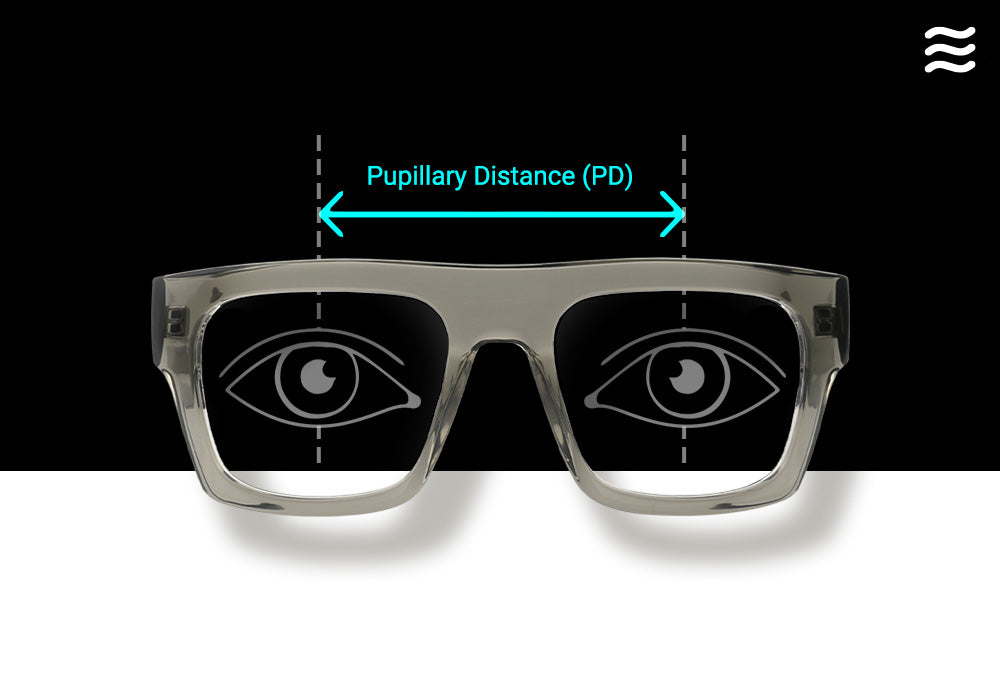
When it comes to ordering prescription glasses, there's a term you'll often see but might not fully understand: Pupillary Distance (PD). PD is a crucial measurement for making accurate prescription eyewear. In this post, we'll break down what PD is, the different types of PD, why it's important, why it's not always included on prescriptions, and how to get it measured.
What is Pupillary Distance (PD)?
Pupillary distance is the measurement, in millimeters, between the centers of your pupils. This distance is essential for aligning the lenses of your glasses with your eyes, ensuring that you look through the optical center of each lens. Proper alignment helps to avoid issues like eye strain, headaches, and blurred vision.
How PD is Measured
There are two primary types of PD measurements:
- Single PD: This is a single number that represents the total distance between the centers of both pupils. It is often used for single vision lenses, which correct for one field of vision (either distance, intermediate, or near). The normal range for single PD in adults is typically between 54mm and 74mm, with an average of about 62mm for men and 60mm for women.
- Dual PD: This provides two separate numbers, representing the distance from the center of each pupil to the bridge of the nose. This is particularly useful for progressive lenses or bifocals, which correct for multiple fields of vision. The normal range for dual PD measurements is typically around 27mm to 37mm for each eye. For example, the measurements might be 32mm for the right eye and 30mm for the left eye. Dual PD ensures that each lens is precisely aligned for its specific prescription zone.
PD for Single Vision vs. Progressive Prescriptions
- Single Vision Prescriptions: Typically, a single PD measurement is sufficient. Single vision lenses correct for a single field of vision, so the alignment of the lenses is straightforward.
- Progressive or Multifocal Prescriptions: These require more precision because they correct for multiple fields of vision (distance, intermediate, and near). Dual PD is often used to ensure each section of the lens aligns correctly with your eyes, providing a smooth transition between different vision zones. You may see "Near PD" and "Dist PD" provided on your prescription. Your PD naturally narrows (by about 3mm) when focusing on an object up close.
Why is PD Important?
PD is crucial for several reasons:
- Optimal Vision: Lenses need to be positioned correctly in front of your eyes. Incorrect PD can lead to lenses that are not aligned properly, causing discomfort and poor vision.
- Comfort: Glasses that don't align with your PD can cause eye strain and headaches because your eyes have to work harder to focus.
- Aesthetic Fit: PD helps in ensuring that the glasses fit your face well, providing a more comfortable and aesthetically pleasing look.
Why Isn't PD Always Included on Prescriptions?
Despite its importance, many eye doctors don't include PD on the prescription. Traditionally, optometrists and ophthalmologists focus on the health and prescription needs of your eyes, leaving the fitting measurements to opticians who actually make your glasses. This practice has carried over from the times when glasses were primarily purchased in-person. However, with the rise of online eyewear shopping, having your PD is essential for ordering glasses that fit well and provide optimal vision.
Getting Your PD Measured
If your PD isn't included in your prescription, don't worry - there are several ways to get it measured. Keep in mind that some methods are more accurate than others, but all should get you where you need to be if performed correctly.
- Ask Your Eye Doctor: Even if your PD isn't on your prescription, your eye doctor can measure it for you. It's a quick and straightforward measurement.
- Opticians: Professional opticians can measure your PD accurately. This is particularly useful if you're getting glasses fitted in person.
- Online Tools: Many online retailers offer tools and guides to measure your PD at home. These can be convenient, but ensure you follow the instructions carefully to get an accurate measurement.
- DIY Method: You can also measure your PD at home using a ruler and a mirror. Simply look straight ahead, measure the distance between the centers of your pupils, and repeat a few times for accuracy.
What You Should Leave With
Understanding your pupillary distance is essential for ensuring that your glasses provide the best vision and comfort. While it's not always included on your prescription, knowing how to measure it or where to get it measured can make a significant difference in your overall experience with your eyeglasses. Always advocate for your vision needs and ensure you have all the necessary measurements to achieve optimal eye health and comfort.
If you're considering purchasing prescription sunglasses online, we hope you choose Neven Eyewear. Our wide selection of customizable frames and lens colors, combined with our easy-to-use online ordering process and quick free delivery will have you seeing the difference in no time.




























































































































































